#reptile evolution
Explore tagged Tumblr posts
Note
I think I'm about to start a debate with this but are. Chickens reptiles because I know they can have salmonella
This isn't even a debate anymore in herpetological circles - all birds are reptiles! (But it's not because they can also have salmonella; most mammals can also have salmonella.) The tl;dr is that birds are dinosaurs, dinosaurs were reptiles, ergo birds are reptiles.
Here's a very simple reptile family tree I drew to help explain why:
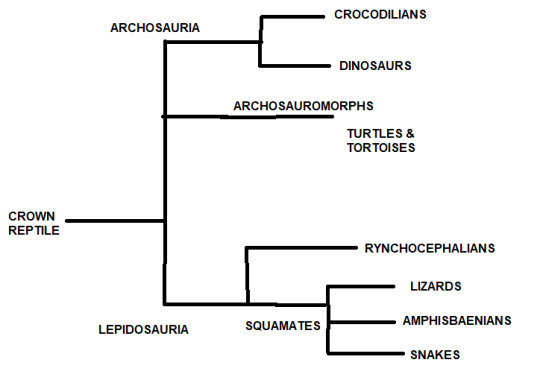
From the crown reptile, which is the common ancestor of all reptiles, we have two major branches - our superorders. The first are the archosaurs. Archosauria has two main branches - crocodilians and dinosaurs. Crocodilians are very closely related to dinosaurs, but it's only about as closely as lizards are related to snakes.
Any classification that includes crocodilians as reptiles must also include birds, because they are on the same branch of the reptile family tree. If you want to exclude birds, fine, you can make an argument that only the Lepidosaurs belong in Reptilia (that’s snakes, lizards, tuatara, and amphisbaenians). But there’s no way to include crocodilians and even turtles in there while excluding birds - crocodiles and birds are more closely related to each other than to any other living reptiles, after all.
Basically, the question really does come down to two options. Either birds are reptiles, or crocodiles and turtles aren’t. If we’re going to classify animals based on evolutionary history, then there’s really no point in half-assing it! The fact of the matter is that birds are more closely related to reptiles than to any other group, and they’re still part of Diapsida, a group which includes all other living and extinct reptiles.
239 notes
·
View notes
Note
A hydra, but each head has jaws and teeth specialized for different food like a one-creature set of the Galapagos Finches

#smaugust#hydra#dragon#suggestion#imagine if you cut the head of the hydra 2 heads appear but the new one has slightly evolved to adapt#y-psigon#a lot is going on this design#somehow when i was little i had a period where i was obsessed with the fauna of galapagos islands so i'm really glad to do this suggestion#the branches and the heads follow the phylogenic tree of the Darwin finches#the overall shape is based on those pictures of tiny islands with 1 single palm tree#the tortoise and iguanas used are from the island too#finch#bird#tortoise#iguana#reptile#Galapagos#Darwin#evolution#the Unknown#990#octem 124#aer 4#monster#chimera#bestiary#creature design#ink
449 notes
·
View notes
Text
As if komodo dragons weren't amazing enough, these giant lizards literally have teeth of iron. A new study of these formidable predators' chompers has revealed concentrated deposits of iron along the serrated tearing edges and the tips of their teeth, helping to keep them razor-sharp for tearing the flesh from the prey they devour. Although many vertebrates have iron enhancements in their teeth, komodo dragons (Varanus komodoensis) and other similar species with serrated teeth, called ziphodonts, represent the most striking examples found to date.
Continue Reading.
298 notes
·
View notes
Text
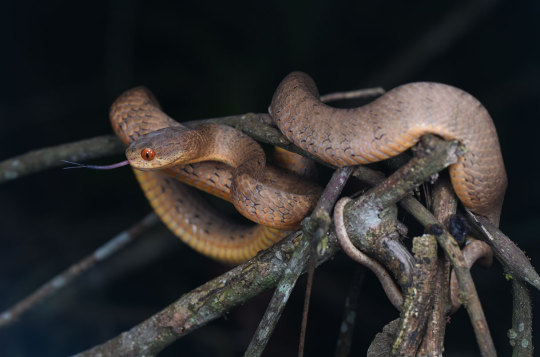
How did snakes lose their limbs? Mass genome effort provides clues
DNA sequencing helps explain how these reptiles got to be so unusual
Snakes are weirdos among vertebrates. Their bodies are typically too thin for more than one lung, they smell with their tongues, and—perhaps most importantly—they have no legs. Now, an extensive effort to sequence the genomes of more than a dozen snake species has uncovered mutations that likely helped make these appendages vanish, as well as the DNA underlying other unusual traits. This research “will undoubtedly have a transformative impact on snake and vertebrate biology,” says Todd Castoe, an evolutionary biologist at the University of Texas at Arlington who was not involved with the work...
Read more: https://www.science.org/content/article/how-did-snakes-lose-their-limbs-mass-genome-effort-provides-clues
Image:
Slug-eating snake (Pareas berdmorei) collected in China was one of 14 snake species newly sequenced to learn about snake adaptations. (Di-Hao Wu)
169 notes
·
View notes
Text

100 Million Years Ago, Snakes Gained Their Most Iconic Traits
The origin story of snakes is still being pieced together, but researchers are confident that their unique jaws, lack of limbs, and elongated figure all emerged at about the same time.
Snakes seem like relatively simple creatures—basically a glorified sock with holes on either end. Yet, these creatures have managed to adapt to nearly every continent on the planet over the past 100 million years. But how exactly did snakes evolve, and what made these slithery creatures so successful across the planet today? It was likely a combination of three factors that all arose at roughly the same time. “It all happens in one singular evolutionary burst around 100 to 110 million years ago, and then after that they pretty much have free reign to the planet every time they go into a new habitat,” says Alex Pyron, a biologist at The George Washington University in Washington, D.C. ...
Read more: https://www.discovermagazine.com/planet-earth/100-million-years-ago-snakes-gained-their-most-iconic-traits
124 notes
·
View notes
Text

Dinocephalosaurus orientalis was a fully aquatic protorosaur reptile living in what is now southwest China during the mid-Triassic, about 244 million years ago.
Up to 6m long (~19'8"), it had a long serpentine body with paddle-like limbs and an especially elongated neck – but despite the superficial similarities to its semi-aquatic cousin Tanystropheus, Dinocephalosaurus' long neck appears to have been independently evolved.
Much like the similarly-shaped elasmosaurs, its neck may have had a "stealth" function, allowing it to bring its jaws closer to targets before the rest of its body was visible, then using side-to-side snapping bites to catch its prey in its interlocking "fish-trap" teeth.
A preserved well-developed embryo inside one specimen also suggests that Dinocephalosaurus gave birth to live young, making it one of only two archosauromorph lineages known to have ever evolved this reproductive strategy.
———
NixIllustration.com | Tumblr | Patreon
#science illustration#paleontology#paleoart#palaeoblr#dinocephalosaurus#dinocephalosauridae#protorosaur#archosauromorpha#reptile#art#convergent evolution
234 notes
·
View notes
Note
if you have time to explain like i'm five, why can birds not be meaningfully separated from reptiles? is it just to do with how they evolved, or are there cold-blooded scaly birds out there that i don't know about?
Imagine you’re a duck. It’s good, right? Here’s some noodles. Pretend they’re worms. Okay, no, stop trying to put the noodles up your nose. Attention here, look, papa’s trying to explain something. Can you listen? If you listen you’ll get more noodles. Okay? Okay.
So you’re a duck (*quack* yes good). But I’m a dinosaur. Yup. Waiiit. You have to be a duck for the story to make sense. Okay. I’m a dinosaur and you’re a duck. You’re descended from me. So you’re actually a dinosaur too! I know right‽ that’s because children (descendants) of one group are still members of that group. You never stop being a dinosaur, no matter how different you look, because you’re descended from dinosaurs. Even though you’re a duck (*quack* yes exactly)
You remember your aunty? Let’s say she’s a crocodile. Yeah, she looks like a crocodile sometimes, doesn’t she? Okay. If she’s a crocodile, and we’re dinosaurs, then what are your grandparents? That’s right, they’re a group that somehow gave rise to both dinosaurs and crocodilians. That group is called Archosauria. So your grandma is a great big archosaur (don’t tell her I said that).
Now, we call archosaurs reptiles. Crocodiles are reptiles, and dinosaurs are reptiles too. And if dinosaurs are reptiles, then birds are reptiles, because you can’t just cut the family tree. No it’s not a literal tree. You can’t cut it. No, not even with scissors. Like I just said, you never stop being what your forebears were. No, forebears, not four bears. Bears are not reptiles. Ducks are. Okay. You get it? Good talk. Here’s some more noodles.
#am I doing this right?#explain like I’m five#more like#explain like I’m three#can you tell I spend a lot of time talking with a 1.5 year old and never with five year olds?#taxonomy#evolution#birds#dinosaurs#reptiles#Answers by Mark#is this scicomm??
896 notes
·
View notes
Text








Comparing Superficial Traits From Opposite Ends of the Sauropsid Family Tree Through a Visual Medium to Make a Point
~OR~
Bird Are Reptiles: The Gifset
Footage Sources: (x)(x)(x)(x)(x)(x)(x)
#lizards#birds#dinosaurs#birds are reptiles#birds are dinosaurs#reptiles#diapsids#sauropsida#evolution#zoology#evolutionary biology#cassowary#green anole#monitor lizard#komodo dragon#seagull#chickens#grouse#peregrine op
122 notes
·
View notes
Text
Legiana (Olhumpiscu cryoetephilos) – Icedrift

Legiana (Olhumpiscu cryetephilos) is a rare and fictional species of saurischian wyvern introduced in Monster Hunter World. The real apex predator in Coral Highlands and possibly Rotten Vale.
Take Note: All of my drawings and photos of people, animals, plants, mythology, disasters, organizations, events, and more are purely fictitious. These are included in real-life situations and events with fictional characters or creatures that aren't real, be at your own risk. For nationality or indigenous, be advised. Ognimdo.
Physiology
Legiana is a slim, primarily beige and navy-blue-colored Flying Wyvern characterized by its leaf-like wingtips and striped skin patterns. Legiana's head is topped with a pair of antenna-like fins, which are attached via a thin membrane to the back of its neck. Legiana's membrane enables it to move at extreme speeds and emit chilling winds.
The Legiana has strong legs that terminate in sharp talons, and it has vivid yellow eyes. Its body is covered in striped patterns of the same hue, and its face, tail, feet, and wingtips are all dark navy blue. It has three retractable fins on its left, right, and dorsal fins, and its wings are divided into four separate flaps that overlap when folded. Legiana's wings are covered in patterns like four-pointed stars. It has a dark blue back as well.
Abilities
Legiana is able to emit a chilling wind from its body, which dulls its prey's ability to escape. It flies with extreme precision and agility, using its talons to grab its prey straight out of the air. Legiana will sometimes fight Paolumu if both flying wyverns come across each other.
Gallery

References
#ognimdo2002#earth responsibly#science fantasy#earth#art#ibispaint art#speculative evolution#art ph#ibispaintx#tangled#assassins creed#rapunzel's tangled adventure#monster hunter#monster hunter world#legiana#flying wyvern#dinosaur#dragon#saurischian#ibispaint#reptile#ice element
40 notes
·
View notes
Text
Wyvern agamid
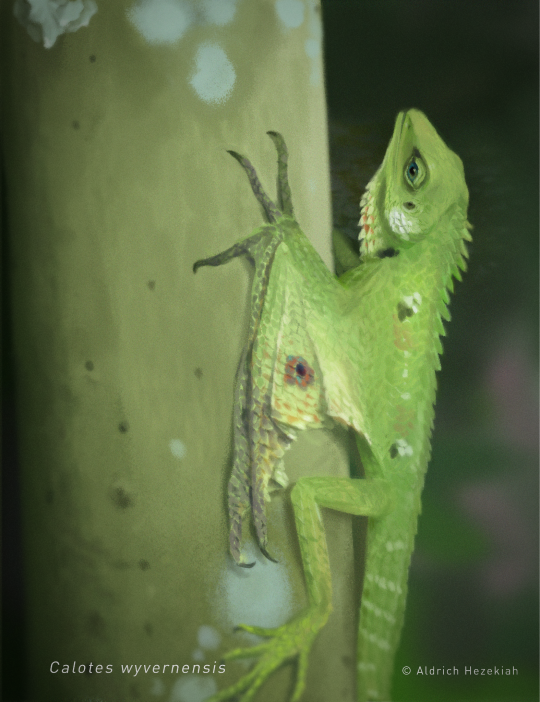
Early sketch and alternate wing ideas

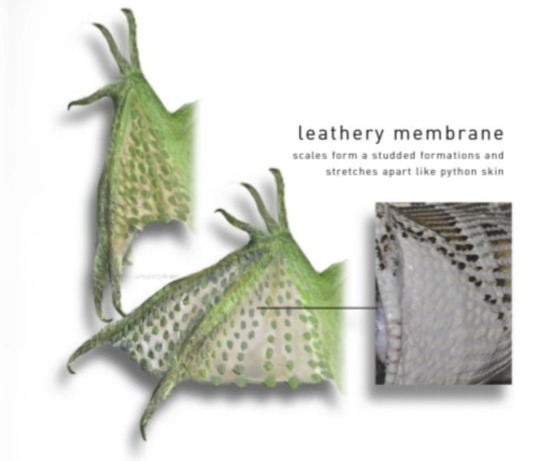
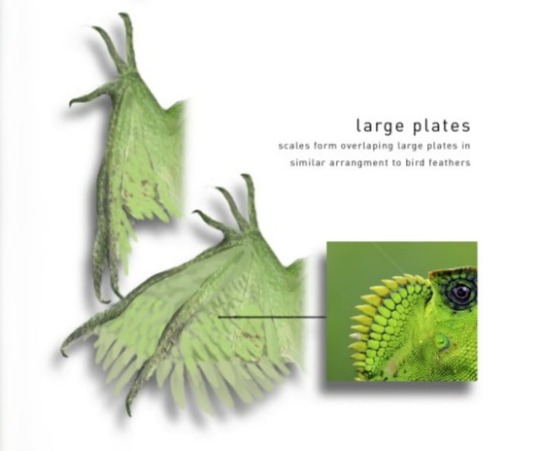
#art#digital art#illustration#creature design#speculativeevolution#speculative evolution#spec evo#agamid#reptile#calotes#garden lizard#fantasy creature#creature
605 notes
·
View notes
Text
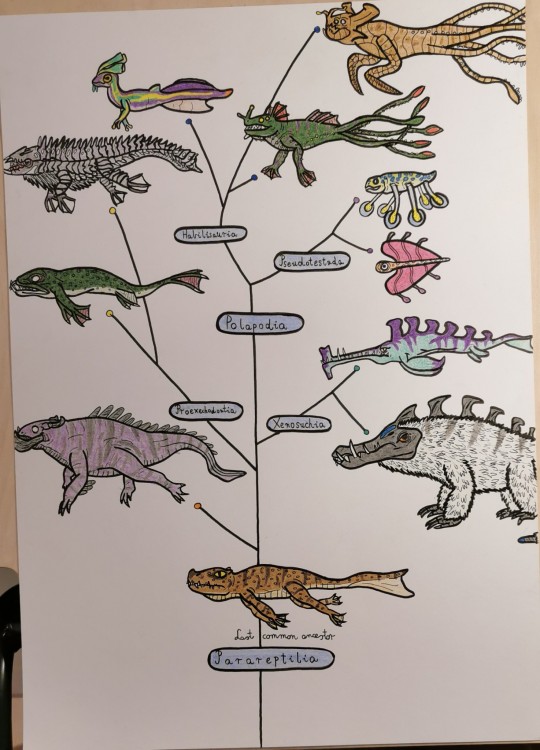
Life on 4546b is in many ways convergent to life on Earth. While many animals we encounter seem to share the most features with fish and various invertebrates, some appear to be more reptilian. It's even possible that their ancestors were once land dwellers, returning to the water as planet's geography changed making it mostly oceanic.
I present a speculative evolutionary tree of Subnautica's parareptiles!
#subnautica#subnatica below zero#speculative evolution#speculative biology#spec evo#stalker#hoverfish#bladderfish#sea emperor leviathan#sea dragon#reptiles#alien biology
46 notes
·
View notes
Note
this isn’t a husbandry question, but do you know why snakes are considered only a suborder taxonomically rather than a full order? It seems like the order squamates is diverse enough that I’d expect it be split into one order for snakes and another for lizards
The general consensus among herpetologists is that squamates, while a very diverse group, have similarities strong enough that it's more useful to consider them all part of the same order rather than split it up. There are actually three suborders in Squamata: snakes, lizards, and amphisbaenians. They all have things that tell us they're members of the same lineage:
Scales. Squamates are also called "scaled reptiles" becuase they all have scaly skin that must be shed every so often. This makes squamates distinct from other reptiles, like crocodilians, who have scutes instead.
Kinetic quadrate bones - they all have bones in their skulls that make it possible to move the upper jaw independently from the rest of the skull. Not every squamate can, but their skull structure makes it possible.
The potential for venom. Not every squamate is venomous (not by a long shot, only about 15% of snakes are venomous and that number is even smaller for lizards), but something like 60% of all squamates belong to clades with venomous members somewhere in their lineage.
Taken all together, these three things that all squamates share tell us that they are extremely closely related and considering them as one order altogether can tell us a great deal about how all squamates evolved. If we considered snakes as their own order instead of a suborder, then we'd lose some perspective on how interrelated all three suborders are.
If we take a look at the single sister order to Squamata, the rhynchocephalians, we can see why no squamates are distinct enough to warrant becoming their own order. Rhynchocephalians, unlike all squamates, have a distinct tooth type, have fused skull bones, do not have the potential for venom, and have a unique skeletal structure including hourglass-shaped vertebrae and gastralia. Snakes are a little different from other squamates, but they're not that different!
95 notes
·
View notes
Text
A speculative arboreal crocodylian

A year ago I began my research on the Mekosuchians, especially around the genus Mekosuchus and my already very strong skepticism at that time about the claims that they were tree-dwelling crocodiles (Something extremely improbable and which I may comment on another occasion. For now you can read in depth about Mekosuchus in this post by Armin).
At that point I wondered ; what would an arboreal crocodile really look like if it existed?
I decided that it would be a derived member of the subfamily Caimaninae, specifically belonging to the Jacarea clade (which includes all species of the genus Caiman and Melanosuchus).
The body has evolved in a convergentely with squamates such as Varanus salvator, being thinner and more elongated than that of any other crocodylian, following the same process the tail : Once the motor that propelled it underwater, is now becoming something similar to a whip that allows it to maintain balance on the branches, losing the characteristic single and double caudal crest whorls, to the point of almost disappearing.
The dorsal osteoderms are shrinking, but are still visible and play an important role in the ecology of the animal, helping it to thermoregulate.
The limbs have been considerably widened and strengthened, an adaptation very visible in the metatarsals of the hind legs, which, together with the sharp, curved claws they have developed, help the animal to cling effectively to trees.
The skull is the most distinctive part of all, as it has not only become shorter and more robust as a whole (Males have even developed an anteorbital crest similar to that of some members of the genus Crocodylus such as C. acutus or the extinct C. checchiai ; very likely some kind of sexual dimorphism), but it is developing unique characteristics such as binocular vision, zyphodont dentition and laterodorsally positioned nostrils, all of these attributes usually associated with terrestrial hunters (although there is not a necessary relationship in all cases), thus moving away from the semi-aquatic lifestyle.
Despite this, these crocodiles are still dependent on water to a certain extent, always inhabiting the forests near the rivers and being able to swim perfectly well if necessary, just like the extant iguanas and monitor lizards.
If I had to add some kind of worldbuilding that allows the existence of this animal, it would probably be located millions of years in the future : After a cataclysmic event related to climate change, South America has suffered a process of desertification in which large bodies of water have dried up, forcing the very abundant babas (Caiman crocodilus) to move into the remaining forests and jungles, adapting to a more terrestrial lifestyle. As an isolated population of these caimans chose the birds and monkeys as their preferred prey, they would gradually follow them to the treetops.
After a few more million years, the land has recovered, and large rivers and lakes are once again flooding South America, favoring the emergence of large tropical jungles again, opening a new world for these tree-dwelling caimans. Will they manage to adapt to the new climatic conditions or will they become extinct as a consequence of this and other factors such as the emergence of new species of placental predators that threaten to occupy their niche? Well, that is uncertain.
The illustration was made in gouache and watercolors during September 2022 . I scupted a small-basic figure made in clay to in order to facilitate the understanding of the lights and shadows.
Here are some pictures of the process:
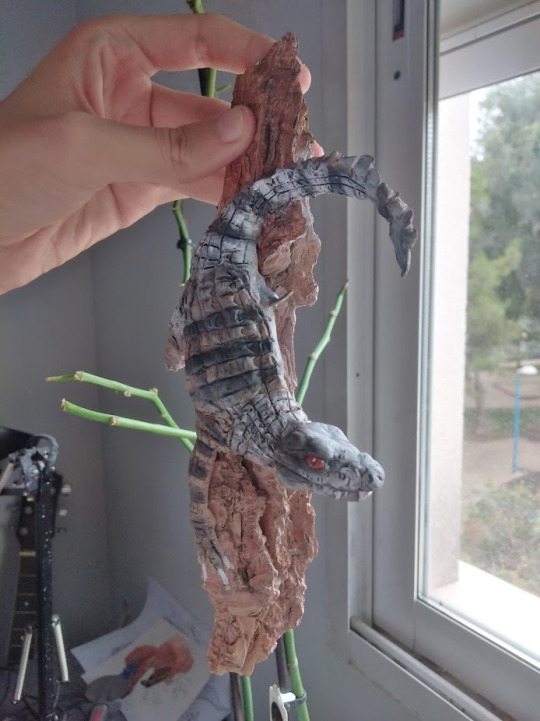
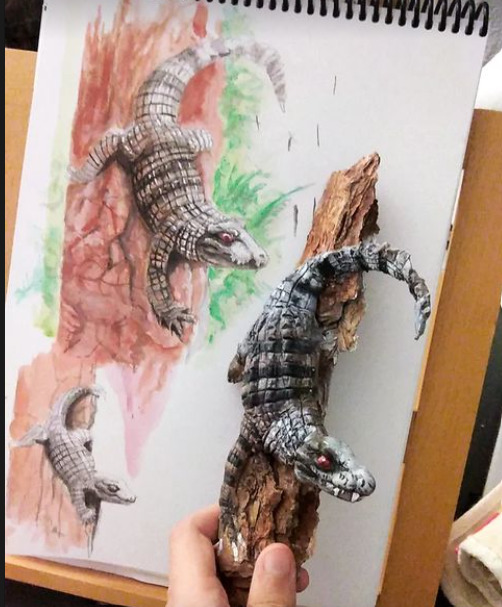
#animals#crocodiles#reptiles#zoology#crocodilians#paleoart#art#nature#speculative biology#speculative evolution#speculative zoology
277 notes
·
View notes
Text
The brightly spotted tokay gecko (Gekko gecko) appears to have a hidden sensory talent akin to a “sixth sense”. The geckos can use a part of the inner ear associated with maintaining balance and body positioning called the saccule to detect low-frequency vibrations. This special sense plays a complementary role in their normal hearing and the way they sense their world. It may also be present in other reptilian species. The findings are detailed in a study published October 4 in the journal Current Biology.
Continue Reading.
101 notes
·
View notes
Text

Meet Vasuki indicus, among the longest snakes that ever lived
Scientists estimate length of the reptile from vertebral remains
Paleontologists have unearthed fossil remains of an ancient giant snake species — almost the length of a large tour bus — dating back to 47 million years old1, and comparable to the longest snakes that have ever lived on earth. They found 27 well preserved fossil vertebrae of Vasuki indicus from a lignite mine in India's Gujarat state, and used them to model the estimated actual length of the snake to somewhere between 10.9 to 15.2 metres. The longest known snake at around 13 metres is the extinct Titanoboa that lived 60 million years ago in present day Colombia. Paleontologists Sunil Bajpai and Debajit Datta at the Indian Institute of Technology in Roorkee say V. Indicus was likely a slow-moving predator that wrapped its body around the prey to squeeze it to death. It evolved in the warm Indian subcontinent and spread to Africa via Europe around 56 to 34 million years ago, they say. V. indicus flourished in forested swamps of the now arid Kutch region...
Read more: https://www.nature.com/articles/d44151-024-00048-0
227 notes
·
View notes
Text
New sophont coming soon

Terribly sorry for spamming with sophonts, but I just feel like I should first upload all of the stuff I’ve acumulated over the past few years building this project (which were mostly sophonts because Total Convergence..? is a lot different from what it started out as). This is a recent drawing of a male Nur’Errkhorr, a species I will talk more about later. The recent female design is from 2022, but this male design got finalized this afternoon. Wow!!!!
#speculative evolution#creature design#artists on tumblr#digital art#spec bio#spec evo#worldbuilding#speculative fiction#creature#2d art#artwork#original art#oc art#speculative biology#original species#original fiction#original character#scifi worldbuilding#worldbuilding project#reptile art#scifi
86 notes
·
View notes